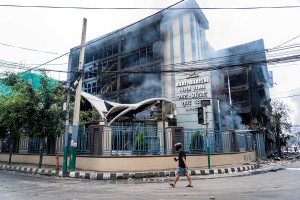Money
Nepal ranks 145th in UN Human Development Index amid digital push
From 1990 to 2023, Nepal’s HDI value increased by 54 percent. The advancement reflects Nepal’s consistent investment in human capital.
Post Report
Nepal has ranked 145th out of 193 countries in the United Nations Development Programme’s (UNDP) Human Development Index (HDI) for 2025, with a score of 0.622. The country remains in the medium human development category, continuing its gradual progress in recent decades.
This year’s Human Development Report, themed “A Matter of Choice: People and Possibilities in the Age of Artificial Intelligence (AI),” warns that global HDI progress, already disrupted by the Covid-19 pandemic, is losing momentum.
The once-narrowing gap between countries with very high and low HDI scores has started to widen again since 2020.
The report explores the choices that countries can make to ensure more equitable development in the AI era, aiming to expand opportunities for all people, regardless of geography or economic status.
Speaking at the report’s launch in Kathmandu, Radhika Aryal, secretary at the Ministry of Communication and Information Technology, said the latest ranking reflects the country’s steady investment in human capital and growing emphasis on digital transformation.
“The advancement in HDI, though modest, reflects our consistent investment in human capital and the growing role of digital innovation in enhancing health, education, and public service delivery,” she said.
Aryal said that internet penetration in Nepal has reached nearly 98 percent, with the youth building a more connected, innovative, and opportunity-driven society. However, she also acknowledged that the benefits of digital transformation are not equally shared.
“Access gaps, limited digital literacy, and underrepresentation in leadership roles remain critical challenges, particularly in underserved communities,” Aryal said.
To address these disparities, the government is undertaking key digital reforms, she added.
“We are revising the Digital Nepal Framework, updating the National Information and Communication Technology Policy, and modernising the Telecommunications Act. At the same time, new instruments such as the Information Technology and Cybersecurity Bill and the National Artificial Intelligence Policy are being developed to guide responsible and secure digital advancement.”
Aryal also emphasised the importance of foundational digital infrastructure.
“The government focuses on national data centres, digital identity platforms, and an integrated e-governance system. These initiatives aim to enhance transparency, strengthen service delivery, and build public trust in digital governance,” she said.
Kyoko Yokosuka, UNDP resident representative for Nepal, highlighted the country’s long-term gains in human development.
Nepal is currently in the medium human development category, ranked 145 out of 193 countries and territories.
From 1990 to 2023, Nepal’s HDI value increased by 54 percent.
This progress, above the global average, reflects Nepal’s efforts to expand access to health and education, implement social protection programmes, and pursue targeted anti-poverty measures.
Despite the achievements, Yokosuka said Nepal still has a long road ahead to reach the high human development category—a goal requiring sustained investment and innovation.
She also acknowledged Nepal’s early-stage engagement with AI.
According to the AI Readiness Index 2024, published by Oxford Insights, Nepal ranks 150th out of 188 countries in its capacity to deploy AI for public services. But there are positive signs.
“While Nepal’s AI journey is just beginning, the government has shown a strong interest in embracing innovation and adapting AI technologies,” Yokosuka said.
Alexandru Oprunenco, regional innovation adviser at the UNDP’s Bangkok Regional Hub, warned that AI will not automatically improve human development outcomes—it will reflect the values and systems in which it is implemented.
“Two-thirds of countries across low, medium, and high HDI categories plan to use AI in education, health, and employment,” he said.
“Nepal can build a complementary economy by focusing on how AI can support—not replace—people, whether they are farmers, students, or civil servants.”
He added that AI could tackle longstanding development challenges, such as uneven service delivery, gender inequality, and education gaps.
“Nepal should invest in capabilities that matter—such as institutional coordination, digital literacy, and inclusive, citizen-centric design—especially across provinces and for underrepresented groups,” Oprunenco said.
A panel discussion titled “Making AI Work for Nepal” explored how the country can shape its AI journey, starting with developing a national AI policy.
Adesh Khadka, joint-secretary at the Ministry of Communication and Information Technology, said the draft AI policy addresses all significant aspects of AI development and deployment.
“We are finalising the policy and launching Digital Nepal Framework 2.0, which includes digital public infrastructure and AI as foundational pillars for the first time in a government document,” he said.
Khadka also highlighted Nepal’s potential to become a regional IT hub. “Our IT industry can serve the international market. Scaling up AI capabilities within this industry would position us well to provide AI services globally,” he said.
“Moreover, Nepal’s abundant green energy resources and climate-friendly data centres make us an attractive location for AI operations, which require substantial energy.”
Parag Shrestha, head of strategy and managing director for South Asia at Fusemachines, echoed this optimism.
“From a pricing and quality perspective—and more importantly, in terms of value and return on investment—international businesses are increasingly interested in Nepali engineers,” he said. “There is significant potential for IT and AI exports from Nepal, worth billions.”
Shrestha said that early adopters of AI in Nepal include data-heavy sectors such as banking, insurance, airlines, and transportation, which are using AI for demand forecasting and improved customer service.
However, he warned that broader AI adoption will require major investments in national infrastructure. “The government must build digital systems that enable AI integration at all levels and across sectors. These systems are expensive but necessary for long-term transformation,” he said.




 8.12°C Kathmandu
8.12°C Kathmandu












%20(1).jpg&w=300&height=200)
